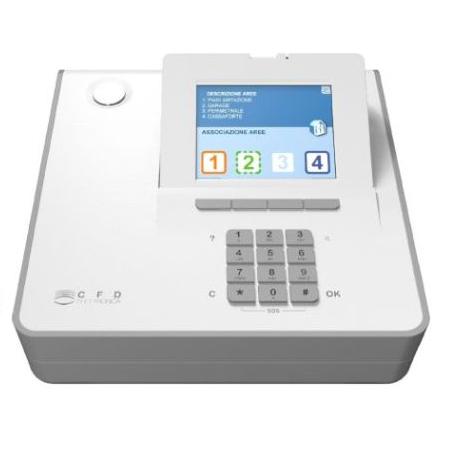CFD Elettronica Plenitude Premium wireless home intrusion detection system
Dec 22, 2004 — by LinuxDevices Staff — from the LinuxDevices Archive — 4 viewsCFD Elettronica's Plenitude Premium is an embedded Linux-based home intrusion detection system with cameras tripped by infrared sensors. It includes 32 fully wireless sensors with a claimed battery life of three years, and can send images to mobile phones using any of three wireless protocols.

The Plenitude Premium control panel is an embedded ARM Linux system
 According to CFD's Joseph Zisa, the Plenitude comes with eight “multimedia” infrared sensors. When motion is detected, an infrared flashlight is activated, and an integrated video camera sends two black-and-white QCIF photos — such as the one at right — to the control panel. The control panel can, in turn, forward the photos to a mobile phone or other GPRS, Bluetooth, or Wi-Fi enabled device, CFD says.
According to CFD's Joseph Zisa, the Plenitude comes with eight “multimedia” infrared sensors. When motion is detected, an infrared flashlight is activated, and an integrated video camera sends two black-and-white QCIF photos — such as the one at right — to the control panel. The control panel can, in turn, forward the photos to a mobile phone or other GPRS, Bluetooth, or Wi-Fi enabled device, CFD says.
The control panel includes a built-in 5.7-inch color display, and can be used for on-demand video surveillance, or to display photos and videos for the 2,000 most recent events, Zisa says.
What's under the hood?
The Plenitude Premium's control panel is based on an SBC (single-board computer) from CompuLab. The CompuLab SBC is powered by a 400MHz Intel XScale PXA255 processor, and includes 64 or 128MB of RAM, and 32 to 64MB of Flash.
The control panel system does not have a hard drive. An external EEPROM is used for system configuration.
The Plenitude Premium includes 32 peripherals, including sensors, actuators, sounders, remote control units, and keypads, each equipped with a bi-directional “Wavenis” radio from Coronis Systems. Eight of the peripherals are the infrared cameras noted above.

Accessories include (left-to-right) a keypad, remote control, magnetic and seismic contact, multimedia infrared sensor, and normal infrared sensor
All peripherals, including the multimedia infrared sensors, are powered by batteries and can run autonomously for three years, CFD says.
The control panel runs a 2.4-series Linux kernel sourced from CompuLab. However, Zisa says the company is working on upgrading the operating system to a 2.6 kernel.
Zisa believes the Plenitude to be the first wireless security device based on an ARM core and embedded Linux, and says the combination enabled the company to implement a “fantastically user-friendly” user interface. The video system uses nano-X on a framebuffer, along with FreeType for fonts, and LibPNG to support PNG image handling.
According to Zisa, the Plenitude Premium was designed and produced in-house over the course of three years. The most challenging part was managing the power usage of the device's radio systems, to allow the sensors to achieve a two-year battery life.
The Plenitude Premium is being manufactured by Francesco Trabucco & Associates, with availability expected in May of 2005 in Italy, with worldwide availability “a few months later,” according to Zisa. The system will be priced at €4,500.
This article was originally published on LinuxDevices.com and has been donated to the open source community by QuinStreet Inc. Please visit LinuxToday.com for up-to-date news and articles about Linux and open source.